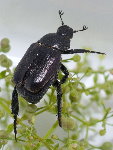Phylum Arthropoda (Arthropods) ➔ Subphylum Hexapoda (Hexapods) ➔ Class Insecta (Insects) ➔ Order Coleoptera (Beetles) ➔ Family Rutelidae (Shining leaf chafers)
Hoplia (Decamera) philanthus (Fuesslin, 1775)
Silbergrauer Einklaulaubkäfer Welsh Chafer
Synonyms and other combinations:
Scarabaeus philanthus Fuesslin, 1775 | Decamera pulverulenta varians Mulsant, 1842 | Hoplia farinosa Thomson, 1863 | Hoplia farinosa istriaca Papp, 1943 | Hoplia misella Schaufuss, 1879 | Hoplia philanthus tumulorum Du Buysson, 1906 | Hoplia (Decamera) ramburi Heyden, 1870 | Melolontha argentea Fabricius, 1775 | Melolontha pulverulenta Fabricius, 1775 ? | Melolontha squamosa Fabricius, 1792 ? | Scarabaeus fuesslini Moll, 1782 |
(?: ambiguous synonym)
Distribution:
Western and Central Europe, especially in hilly or mountainous regions.Habitat:
On willows on banks of rivers and lakes.Description:
Length 8 - 9 mm; black or blackish brown; upper side covered with very small ovate scales, hairs between them not longer than the scales; pygidium tip truncated; wing covers wider than the pronotum; pronotum widest just before the middle, upper side densely and finely dotted; head and pronotum with short, strong protruding hairs; head densely grained; scutellum slightly longer than broad, with parallel sides at base; fore tibiae with outer edge teeth; hind tibiae relatively long; claw of hind tarsi split near tip.Biology:
Hoplia philanthus flies from June to August. The beetles feed on leaves. They are often found on willows, young fruit trees and pines, on corn stalks and sometimes also on flowers.The females begin laying their eggs in the last June week. A female lays approx. 25 - 40 eggs 10 to 15 cm deep into the ground. About 4 weeks later the larvae hatch and start to feed on subterranean plant parts. The larvae undergo 3 larval stages and spend the winter in the 2nd and 3rd stages. After the 2nd hibernation they pupate. The pupal period lasts about 4 weeks. At the beginning of June the new beetle generation appears.
Note:
In case of mass occurrence, the larvae of Hoplia philanthus can cause damage to lawns, ornamental plants and young trees in tree nurseries by eating roots.References, further reading, links:
- Schoolmeesters P. (2019). Scarabs: World Scarabaeidae Database (version Jan 2019). In: Species 2000 & ITIS Catalogue of Life, 2019 Annual Checklist (Roskov Y., Ower G., Orrell T., Nicolson D., Bailly N., Kirk P.M., Bourgoin T., DeWalt R.E., Decock W., Nieukerken E. van, Zarucchi J., Penev L., eds.). Digital resource at www.catalogueoflife.org/annual-checklist/2019. Species 2000: Naturalis, Leiden, the Netherlands. ISSN 2405-884X.
- Arved Lompe: Die Käfer Europas - Ein Bestimmungswerk im Internet
- Harde, Severa: Der Kosmos Käferführer: Die Käfer Mitteleuropas, Franckh-Kosmos Verlags-GmbH & KG, Stuttgart, ISBN 3-440-07682-2.
- Ansari MA, Casteels H, Tirry L, Moens M.: Biology of Hoplia philanthus (Col., Scarabaeidae, Melolonthinae): A New and Severe Pest in Belgian Turf. Environ Entomol. 2006;35:1500–1507. doi: 10.1093/ee/35.6.1500.


